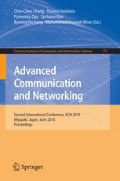Abstract
In IP networks, each computer or communication equipment needs an IP address. To supply enough IP addresses, the new Internet protocol IPv6 is used in next generatoion mobile communication. Although IPv6 improves the existing IPv4 Internet protocol, Duplicate Address Detection (DAD) mechanism may consume resources and suffer from long delay. DAD is used to ensure whether the IP address is unique or not. When a mobile node performs an inter-domain handoff, it will first generate a new IP and perform a DAD procedure. The DAD procedure not only wastes time but also increases the signaling load on Internet. In this paper, the author proposes a new DAD mechanism to speed up the DAD procedure. A DAD table is created in access or mobility routers in IP networks and record all IP addresses of the area. When a new IP address needs to perform DAD, it can just search in the DAD table to confirm the uniqueness of the address.
Access this chapter
Tax calculation will be finalised at checkout
Purchases are for personal use only
Preview
Unable to display preview. Download preview PDF.
References
Lin, Y.-B., Huang, Y.-R., Pang, A.-C., Chlamtac, I.: All-IP Approach for Third Generation Mobile Networks. IEEE Netw. 16(5), 8–19 (2002)
Lin, Y.-B., Pang, A.-C.: Wireless and Mobile All-IP Networks. Wiley, Chichester (2005)
Zahariadis, T.B., Vaxevanakis, K.G., Tsantilas, C.P., Zervos, N.A., Nikolaou, N.A.: Global roaming in next-generation networks. IEEE Communi. Mag. 40(2), 145–151 (2002)
Bos, L., Leroy, S.: Toward an all-IP-based UMTS system architecture. IEEE Network 15(1), 36–45 (2001)
Deering, S., Hinden, R.: Internet Protocol, Version 6(IPv6) Specification, IETF RFC 2460 (December 1998)
Narten, T., Nordmark, E., Simpson, W.: Neighbor Discovery for IPv6. IETF RFC 2461 (December 1998)
Thomaon, S., Narten, T.: IPv6 Stateless Address Autocofiguration. IETF RFC 2462 (December 1998)
Weniger, K., Zitterbart, M.: Address Autoconfiguration in Mobile Ad Hoc Networks: Current Approaches and Future Directions. IEEE Netw., 6–11 (July/Auguest 2004)
Perkins, C.E., Johnson, D.B.: Mobility support in IPv6. In: Proc. Intern. Conf. Mobile Computing and Networking (November 1996)
Wang, T.-P., Tsui, C.-L.: Path Optimization under Delay Constraints in Mobile IP over MPLS Networks. IEICE Trans. Commun. 87(9), 2605–2612 (2004)
Nakajima, N., Dutta, A., Das, S., Schulzrinne, H.: Handoff Delay Analysis and Measurement for SIP based mobility in IPv6. In: IEEE Intern. Conf. Commun., vol. 2 (May 2003)
Lee, C.-W., Lee, J.-H.: Fast and Lossless Handoff Method considering Duplicate Address Dection in IPv6-based Mobile Networks,Wireless and Mobile Communications. In: Proc. SPIE, APOC 2001, Beijing, China. vol. 4586 (2001)
Bagnulo, M., Soto, I.: Random Generation of Interface Identifiers. Internet-Draft (July 2002)
Wasserman, M.: Recommendations for IPv6 in 3GPP Standard. IETF RFC 3314 (September 2002)
Vaidya, N.H.: Weak Duplicate Address Detection in Mobile Ad Hoc Networks. In: Proc. ACM MobiHoc 2002, Switzerland, pp. 206–216 (June 2002)
Weniger, K.: Passive Duplicate Address Detection in Mobile Ad Hoc Networks. In: Proc. IEEE WCNC 2003, New Orleans, LA (March 2003)
Radke, C.E.: The use of quadratic residue research. Commun. ACM 13 (Febuary 1970)
Knuth, D.E.: The art of computer programming, vol. 3, pp. 506–540. Addison-Wesley Publishing, Reading (1973)
Author information
Authors and Affiliations
Editor information
Editors and Affiliations
Rights and permissions
Copyright information
© 2010 Springer-Verlag Berlin Heidelberg
About this paper
Cite this paper
Alisherov, F., Kim, T. (2010). Duplicate Address Detection Table in IPv6 Mobile Networks. In: Chang, CC., Vasilakos, T., Das, P., Kim, Th., Kang, BH., Khurram Khan, M. (eds) Advanced Communication and Networking. ACN 2010. Communications in Computer and Information Science, vol 77. Springer, Berlin, Heidelberg. https://doi.org/10.1007/978-3-642-13405-0_11
Download citation
DOI: https://doi.org/10.1007/978-3-642-13405-0_11
Publisher Name: Springer, Berlin, Heidelberg
Print ISBN: 978-3-642-13404-3
Online ISBN: 978-3-642-13405-0
eBook Packages: Computer ScienceComputer Science (R0)

